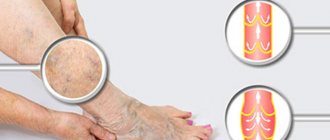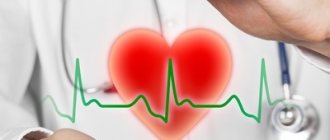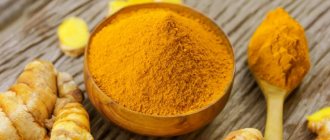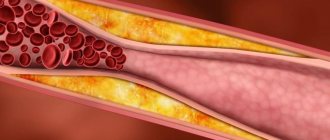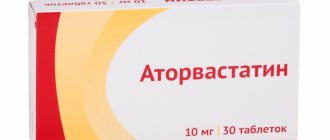Among lipid-lowering drugs produced in tablet form, the most popular are drugs under the commercial names Atorvastatin and Atoris.
In this regard, some patients have a question about which is better - Atorvastatin or Atoris. These drugs have the same effect, but are produced by different manufacturers. Both are intended to normalize blood cholesterol levels and are prescribed to patients with atherosclerosis.
Nosological classification (ICD-10)
- E14 Diabetes mellitus, unspecified
- E78 Disorders of lipoprotein metabolism and other lipidemias
- E78.0 Pure hypercholesterolemia
- E78.1 Pure hyperglyceridemia
- E78.2 Mixed hyperlipidemia
- E78.5 Hyperlipidemia, unspecified
- E78.9 Disorders of lipoprotein metabolism, unspecified
- I10 Essential (primary) hypertension
- I15 Secondary hypertension
- I20.9 Angina pectoris, unspecified
- I21.9 Acute myocardial infarction, unspecified
- I25.9 Chronic ischemic heart disease, unspecified
- I64 Stroke not specified as hemorrhage or infarction
- Z72.0 Tobacco use
- Z82.4 Family history of coronary heart disease and other diseases of the cardiovascular system
Compound
| Film-coated tablets | 1 table |
| core: | |
| active substance: | |
| atorvastatin calcium | 10.36 mg |
| 20.72 mg | |
| (equivalent to 10 or 20 mg atorvastatin, respectively) | |
| excipients: povidone K25 - 5.8/11.6 mg; sodium lauryl sulfate - 2.9/5.8 mg; calcium carbonate - 31.84/63.68 mg; MCC - 29/58 mg; lactose monohydrate - 57.125/114.25 mg; croscarmellose sodium - 7.25/14.5 mg; magnesium stearate - 0.725/1.45 mg | |
| film shell: Opadry II HP 85F28751 white (polyvinyl alcohol - 1.74/3.48, titanium dioxide (E171) - 1.9/2.18, macrogol 3000 - 0.88/1.76, talc - 0.64 /1.28) - 4.35/8.7 mg |
| Film-coated tablets | 1 table |
| core: | |
| active substance: | |
| atorvastatin calcium | 31.08 mg |
| 62.16 mg | |
| 82.88 mg | |
| (equivalent to 30, 60 and 80 mg atorvastatin, respectively) | |
| excipients: lactose monohydrate - 175.24/350.49/467.32 mg; MCC - 52.5/105/140 mg; hyprolose - 6/12/16; croscarmellose sodium - 15/30/40 mg; crospovidone, type A - 15/30/40 mg; polysorbate 80 - 0.68/1.35/1.8 mg; sodium hydroxide - 1.5/3/4 mg; magnesium stearate – 3/6/8 mg | |
| film shell: Opadry II HP 85F28751 white (polyvinyl alcohol - 3.6/7.2/9.6 mg, titanium dioxide (E171) - 2.25/4.5/6 mg, macrogol 3000 - 1.82/3 .64/4.85 mg, talc - 1.33/2.66/3.55 mg) - 9/18/24 mg |
| Film-coated tablets | 1 table |
| core: | |
| active substance: | |
| atorvastatin calcium | 41.44 mg |
| (equivalent to 40 mg atorvastatin) | |
| excipients: povidone K25 - 23.2 mg; sodium lauryl sulfate - 11.6 mg; calcium carbonate - 127.36 mg; MCC - 116 mg; lactose monohydrate - 199.5 mg; croscarmellose sodium - 29 mg; crospovidone - 29 mg; magnesium stearate - 2.9 mg | |
| film shell: Opadry white Y-1-7000 (hypromellose - 10.87 mg, titanium dioxide (E171) - 5.44 mg, macrogol 400 - 1.09 mg) - 17.4 mg |
Description of the dosage form
Tablets, 10 and 20 mg: round, slightly biconvex, white film-coated. Fracture appearance: white rough mass with a white or almost white film shell.
Tablets, 30 mg: round, slightly biconvex, film-coated, white or almost white, with a bevel.
Tablets, 60 mg: oval, biconvex, film-coated, white or almost white.
Tablets, 80 mg: capsule-shaped, biconvex, film-coated, white or almost white.
Tablets, 40 mg: round, slightly biconvex, white or almost white film-coated. Fracture appearance: white rough mass with a white or almost white film shell.
Pharmacodynamics
Atorvastatin is a lipid-lowering drug from the group of statins. The main mechanism of action of atorvastatin is the inhibition of the activity of HMG-CoA reductase, an enzyme that catalyzes the conversion of HMG-CoA to mevalonic acid. This transformation is one of the early stages in the chain of cholesterol (C) synthesis in the body. Suppression of cholesterol synthesis by atorvastatin leads to increased reactivity of LDL receptors in the liver, as well as in extrahepatic tissues. These receptors bind LDL particles and remove them from the blood plasma, which leads to a decrease in the concentration of LDL-C in the blood.
The antiatherosclerotic effect of atorvastatin is a consequence of its effect on the walls of blood vessels and blood components. Atorvastatin inhibits the synthesis of isoprenoids, which are growth factors for the cells of the inner lining of blood vessels. Under the influence of atorvastatin, endothelium-dependent dilation of blood vessels improves, the concentration of LDL-C, apolipoprotein B, and triglycerides (TG) decreases, and the concentration of HDL-C and apolipoprotein A increases.
Atorvastatin reduces the viscosity of blood plasma and the activity of certain coagulation factors and platelet aggregation. Thanks to this, it improves hemodynamics and normalizes the state of the coagulation system. HMG-CoA reductase inhibitors also affect the metabolism of macrophages, block their activation and prevent rupture of atherosclerotic plaque.
As a rule, the therapeutic effect of atorvastatin is observed after 2 weeks of treatment, and the maximum effect develops after 4 weeks.
Atorvastatin at a dose of 80 mg significantly reduces the risk of ischemic complications (including death from myocardial infarction) by 16%, and the risk of re-hospitalization for angina pectoris accompanied by signs of myocardial ischemia by 26%.
Characteristics of drugs
Atoris was developed as an analogue of the German-made statin Liprimar. The latter was expensive and therefore was inaccessible to some patients. Atoris is almost identical to the original in composition and effectiveness in lowering cholesterol levels. Its active ingredient is atorvastatin.
While taking Atoris, the following happens:
- acceleration of blood flow;
- decrease in triglyceride levels in the blood;
- blood thinning;
- suppression of the production of substances that can accumulate on the intravascular wall;
- slowing down platelet pooling;
- restoration of blood movement through the vessels;
- prevention of rupture of cholesterol plaques.
Atorvastatin is a drug from the group of 3rd generation statins. It is produced by both Russian and Israeli pharmaceutical companies. This drug actively affects reductase, resulting in a decrease in cholesterol levels and a halt in atherosclerotic processes. Atorvastatin is available in three dosages - 10, 20 and 40 mg.
Atorvastatin is produced in Russia and is an analogue of Atoris
The excipient composition varies depending on the country in which it is produced and the specific pharmaceutical company. Among domestic manufacturers, Atorvastatin is produced by the following companies: Kanonpharma, Severnaya Zvezda, Vertex, Izvarino Pharma, Irbitsky HFZ. The cost of a Russian-made drug varies from 120 to 800 rubles, depending on the dosage and number of tablets in the package.
Atoris is produced by the Slovenian pharmaceutical company KRKA. The cost of the drug is higher than the price of Atorvastatin, and averages 600 rubles. Despite the different price categories, both drugs have a good therapeutic effect and can effectively reduce blood cholesterol levels.
Pharmacokinetics
Absorption of atorvastatin is high, approximately 80% is absorbed from the gastrointestinal tract. The degree of absorption and plasma concentration increase in proportion to the dose. Tmax is on average 1–2 hours. In women, Tmax is 20% higher, and AUC is 10% lower. Differences in pharmacokinetics in patients by age and gender are insignificant and do not require dose adjustment.
In patients with alcoholic cirrhosis, Tmax is 16 times higher than normal. Eating slightly reduces the rate and duration of drug absorption (by 25 and 9%, respectively), but the decrease in LDL-C concentration is similar to that when using atorvastatin without food.
The bioavailability of atorvastatin is low (12%), systemic bioavailability of inhibitory activity against HMG-CoA reductase is 30%. Low systemic bioavailability is due to first-pass metabolism in the gastrointestinal mucosa and primary passage through the liver.
The average Vd of atorvastatin is 381 l. More than 98% of atorvastatin is bound to plasma proteins. Atorvastatin does not penetrate the BBB. Metabolized predominantly in the liver under the influence of the CYP3A4 isoenzyme of cytochrome P450 with the formation of pharmacologically active metabolites (ortho- and parahydroxylated metabolites, beta-oxidation products), which account for approximately 70% of the inhibitory activity against HMG-CoA reductase for 20–30 hours.
T1/2 of atorvastatin is 14 hours. It is excreted mainly in bile (it is not subject to pronounced enterohepatic recirculation and is not excreted during hemodialysis). Approximately 46% of atorvastatin is excreted through the intestines and less than 2% by the kidneys.
Special patient groups
Children. Pharmacokinetic studies have not been conducted in children.
Elderly patients. Cmax and AUC of the drug in elderly patients (over 65 years of age) are 40 and 30%, respectively, higher than those in young adult patients (no clinical significance).
Renal dysfunction. Impaired renal function does not affect the concentration of atorvastatin in the blood plasma or its effect on lipid metabolism; therefore, no change in the dose of the drug is required in patients with impaired renal function.
Liver dysfunction. The concentration of the drug is significantly increased (Cmax - approximately 16 times, AUC - approximately 11 times) in patients with alcoholic cirrhosis of the liver (Class B according to the Child-Pugh classification).
How do drugs work?
Both drugs contain atorvastatin as the active ingredient. It prevents the synthesis of the HMG enzyme - Coa reductase and normalizes the production of mevalonic acid. It directly affects the synthesis of cholesterol in liver cells. Both Atorvastatin and Atoris reduce the amount of cholesterol produced, which triggers low-density lipoprotein receptors.
As a result of regular intake of drugs, the blood plasma is cleared of cholesterol. In addition, the active components of drugs suppress the production of very low density lipids, which leads to a decrease in the synthesis of triglycerides. In addition to reducing the level of bad cholesterol, the drugs in question have a positive effect on the lining of blood vessels, dilating them.
Blood viscosity is also reduced and the formation of atherosclerotic deposits is prevented. Taking such statins significantly reduces the risk of developing complications of atherosclerosis in the form of heart attack and stroke. If we compare how the pharmacokinetics of these drugs differ, we can see that these indicators for all 3rd generation statins are almost the same:
- the highest concentration is achieved 2 hours after taking the medicine;
- the effect of the drugs does not depend on the gender and age of the patient;
- there is a decrease in the absorption of statins if they were taken after meals;
- the active substances of the drugs are able to overcome the placental barrier and penetrate into breast milk;
- the bioavailability of each of them is 12%;
- metabolites formed in the liver provide protection for 30 hours;
- the components of the drugs are excreted from the body with bile and feces.
Indications for the drug Atoris®
For dosages of 10, 20 mg
primary hypercholesterolemia (heterozygous familial and non-familial hypercholesterolemia (Fredrickson type II);
combined (mixed) hyperlipidemia (Fredrickson types IIa and IIb);
dysbetalipoproteinemia (Fredrickson type III) (as an addition to the diet);
familial endogenous hypertriglyceridemia (Fredrickson type IV), resistant to diet;
homozygous familial hypercholesterolemia with insufficient effectiveness of diet therapy and other non-pharmacological treatments;
For dosages of 30, 40, 60, 80 mg
primary hypercholesterolemia (heterozygous familial and non-familial hypercholesterolemia (Fredrickson type II);
combined (mixed) hyperlipidemia (Fredrickson types IIa and IIb);
dysbetalipoproteinemia (Fredrickson type III) (as an addition to the diet);
familial endogenous hypertriglyceridemia (Fredrickson type IV), resistant to diet;
homozygous familial hypercholesterolemia with insufficient effectiveness of diet therapy and other non-pharmacological treatments;
For all dosages
Prevention of cardiovascular diseases:
primary prevention of cardiovascular complications in patients without clinical signs of coronary heart disease, but with several risk factors for its development: age over 55 years, nicotine addiction, arterial hypertension, diabetes mellitus, low levels of HDL-C in the blood plasma, genetic predisposition, in incl. against the background of dyslipidemia;
secondary prevention of cardiovascular complications in patients with coronary heart disease (CHD) in order to reduce the total mortality rate, myocardial infarction, stroke, readmission for angina pectoris and the need for revascularization.
What we are treated with: Atoris. Live with pain or die young?
That said, statins do increase the risk of diabetes, cause muscle pain, and may be harmful to the liver, but these risks are still quite low, according to a comparative analysis of 135 studies. And here, atorvastatin was on par with other statins, and pravastatin and simvastatin caused the least side effects. Although it appears that muscle pain due to statins may be underestimated in clinical trials, serious muscle damage occurs in 1 to 2 people per 10,000 drug-years, a systematic review in The Canadian Journal of Cardiology concluded.
Less serious consequences, which the instructions warn about (nausea, digestive problems, loose stools, pain in muscles and joints) are much more common - in 1-10% of patients. Also, the US Food and Drug Administration (FDA) in 2014 reported forgetfulness and distraction when taking statins, but these problems stopped after patients stopped taking the drug.
In terms of recommendations for HIV-positive patients and people taking hemofibrozil, atorvastatin may be a less dangerous option than other statins, as the risk of side effects is increased in patients in these groups.
Indicator.Ru recommends: use at increased risk of heart attack and stroke
Atoris really slows down the development of atherosclerosis and other cardiovascular diseases that increase the likelihood of heart attack and stroke. Its active ingredient is a fairly strong statin and is effective in different dosages: when taken 10 mg per day, it reduces blood cholesterol levels by 27%, and 80 mg per day - by 37.9%, another Cochrane review reports.
And although the side effects of statins are unpleasant, and a significant improvement and complete cure cannot be expected from them, you should not stop taking them without your doctor’s permission. But in reality, the choice is not so stark: according to statistics, health-threatening events (for example, the development of diabetes, serious liver or muscle damage) are considered very rare, and more common symptoms, such as muscle pain or nausea, are not dangerous. Despite this, while some patients use statins for prevention when they are healthy (this is especially common in the United States and Europe), others abandon therapy that could extend their lives by years.
The truth here is somewhere in the middle: the benefit of the drug for healthy people remains in question, although it is unlikely that statins cause significant harm to them. However, there is hope for the benefit of prevention: A 2013 Cochrane review shows that statins help prevent cardiovascular events in an average of 18 out of 1,000 patients who initially had hypertension, diabetes or high cholesterol. Therefore, in the case of statins, everything depends on the patient’s condition.
Of course, you shouldn’t forget about a healthy lifestyle: sometimes it’s enough to stop eating fatty foods to lower your blood cholesterol levels to normal levels without the help of medications. And even along with medications, a healthy diet will not harm you either.
Our recommendations cannot be equated with a doctor's prescription. Before you start taking this or that drug, be sure to consult a specialist.
Did you like the material? Add Indicator.Ru to “My Sources” of Yandex.News and read us more often.
Subscribe to Indicator.Ru on social networks: Facebook, VKontakte, Twitter, Telegram, Odnoklassniki.
Contraindications
hypersensitivity to any of the components of the drug;
liver diseases in the active stage (including active chronic hepatitis, chronic alcoholic hepatitis);
liver failure;
liver cirrhosis of any etiology;
increased activity of liver transaminases of unknown origin by more than 3 times compared to ULN;
skeletal muscle diseases;
lactase deficiency, lactose intolerance, glucose-galactose malabsorption syndrome;
pregnancy and breastfeeding;
age under 18 years (efficacy and safety of use have not been established).
With caution: alcoholism; history of liver disease.
Atoris 30mg n30 tab
Description of the active substance (INN):
Atorvastatin
Dosage form:
film-coated tablets
Pharmachologic effect:
A lipid-lowering drug from the group of statins. A selective competitive inhibitor of HMG-CoA reductase, an enzyme that converts 3-hydroxy-3-methylglutaryl coenzyme A into mevalonic acid, which is a precursor of sterols, including cholesterol. TG and cholesterol in the liver are included in VLDL, enter the plasma and are transported to peripheral tissues. LDL is formed from VLDL through interaction with LDL receptors. Reduces plasma cholesterol and lipoprotein levels by inhibiting HMG-CoA reductase, cholesterol synthesis in the liver and increasing the number of “liver” LDL receptors on the cell surface, which leads to increased uptake and catabolism of LDL. Reduces the formation of LDL, causes a pronounced and persistent increase in the activity of LDL receptors. Reduces LDL levels in patients with homozygous familial hypercholesterolemia, which usually does not respond to treatment with lipid-lowering drugs. Reduces the level of total cholesterol by 30-46%, LDL - by 41-61%, apolipoprotein B - by 34-50% and TG - by 14-33%; causes an increase in the level of HDL cholesterol (high density lipoprotein) and apolipoprotein A. Dose-dependently reduces the level of LDL in patients with homozygous hereditary hypercholesterolemia, resistant to therapy with other lipid-lowering drugs. Significantly reduces the risk of developing ischemic complications (including the development of death from myocardial infarction) by 16%, the risk of re-hospitalization for angina pectoris, accompanied by signs of myocardial ischemia, by 26%. Does not have carcinogenic or mutagenic effects.
Indications:
Primary hypercholesterolemia (heterozygous familial and non-familial hypercholesterolemia, Frederickson type IIa), combined (mixed) hyperlipidemia (Frederickson types IIb and III), dysbetalipoproteinemia (Frederickson type III) (as an addition to diet), familial endogenous hypertriglyceridemia (Frederickson type type IV), resistant to dietary treatments. Homozygous hereditary hypercholesterolemia (as an addition to lipid-lowering therapy, including autohemotransfusion of blood purified from LDL). Cardiovascular diseases associated with dyslipidemia, secondary prevention to reduce the total risk of death, myocardial infarction and re-hospitalization for angina pectoris.
Contraindications:
Hypersensitivity, active liver diseases (including active chronic hepatitis, chronic alcoholic hepatitis), increased activity of “liver” transaminases (more than 3 times) of unknown origin, liver failure (severity grades A and B on the Child-Pug scale) , pregnancy, lactation period. With caution. Severe electrolyte imbalance, endocrine and metabolic disorders, alcoholism, history of liver disease, arterial hypotension, severe acute infections, uncontrolled seizures, major surgical interventions, trauma, childhood (efficacy and safety of use have not been established).
Side effects:
From the nervous system: more often 2% - insomnia, dizziness; less often 2% - headache, asthenia, malaise, drowsiness, unusual dreams, amnesia, paresthesia, peripheral neuropathy, amnesia, emotional lability, ataxia, facial paralysis, hyperkinesis, depression, hyperesthesia, loss of consciousness. From the senses: less often 2% - amblyopia, tinnitus, dry conjunctiva, impaired accommodation, hemorrhage in the eyes, deafness, glaucoma, parosmia, loss of taste, taste perversion. From the cardiovascular system: more often 2% - chest pain; less than 2% - palpitations, vasodilation, migraine, postural hypotension, increased blood pressure, phlebitis, arrhythmia, angina pectoris. From the hematopoietic system: less than 2% - anemia, lymphadenopathy, thrombocytopenia. From the respiratory system: more often 2% - bronchitis, rhinitis; less often 2% - pneumonia, dyspnea, bronchial asthma, nosebleeds. From the digestive system: more often 2% - nausea; less than 2% - heartburn, constipation or diarrhea, flatulence, gastralgia, abdominal pain, anorexia, decreased or increased appetite, dry mouth, belching, dysphagia, vomiting, stomatitis, esophagitis, glossitis, erosive and ulcerative lesions of the oral mucosa, gastroenteritis, hepatitis, biliary colic, cheilitis, duodenal ulcer, pancreatitis, cholestatic jaundice, liver dysfunction, rectal bleeding, melena, bleeding gums, tenesmus. From the musculoskeletal system: more often than 2% - arthritis; less than 2% - leg muscle cramps, bursitis, tenosynovitis, myositis, myopathy, arthralgia, myalgia, rhabdomyolysis, torticollis, muscle hypertonicity, joint contractures. From the genitourinary system: more often than 2% - urogenital infections, peripheral edema; less often 2% - dysuria (including pollakiuria, nocturia, urinary incontinence or urinary retention, imperative urge to urinate), nephritis, hematuria, vaginal bleeding, nephrourolithiasis, metrorrhagia, epididymitis, decreased libido, impotence, ejaculation disorder. From the skin: more often than 2% - alopecia, xeroderma, increased sweating, eczema, seborrhea, ecchymosis, petechiae. Allergic reactions: less often 2% - skin itching, skin rash, contact dermatitis, rarely - urticaria, angioedema, facial swelling, photosensitivity, anaphylaxis, exudative erythema multiforme (including Stevens-Johnson syndrome), toxic epidermal necrolysis (syndrome) Lyell). Laboratory indicators: less than 2% - hyperglycemia, hypoglycemia, increased serum CPK, albuminuria. Other: less than 2% - weight gain, gynecomastia, mastodynia, exacerbation of gout. Overdose. Treatment: there is no specific antidote; symptomatic therapy is carried out. Hemodialysis is ineffective.
Directions for use and dosage:
Orally, take at any time of the day, regardless of meals. The initial dose is 10 mg 1 time per day. The dose should be changed at intervals of at least 4 weeks. The maximum daily dose is 80 mg in 1 dose. For primary hypercholesterolemia and combined (mixed) hyperlipidemia, 10 mg is prescribed once a day. The effect appears within 2 weeks, the maximum effect is observed within 4 weeks. For homozygous familial hypercholesterolemia, 80 mg is prescribed once a day (reducing LDL levels by 18-45%). Before starting therapy, the patient must be prescribed a standard hypocholesterolemic diet, which he must follow during treatment.
Special instructions:
Atorvastatin may cause an increase in serum CPK levels, which should be taken into account in the differential diagnosis of chest pain. It is necessary to regularly monitor liver function indicators before starting treatment, 6 and 12 weeks after starting the drug or after increasing the dose, as well as periodically during the entire period of use (until the condition of patients whose transaminase levels exceed normal levels is completely normalized). An increase in liver transaminases is observed mainly in the first 3 months of drug use. It is recommended to discontinue the drug or reduce the dose if AST and ALT levels increase more than 3 times. Atorvastatin should be temporarily discontinued if clinical symptoms suggestive of acute myopathy develop, or if there are factors predisposing to the development of acute renal failure due to rhabdomyolysis (severe infections, hypotension, traumatic surgery, trauma, metabolic, endocrine or severe electrolyte disturbances). Patients should be warned to seek immediate medical attention if they experience unexplained muscle pain or weakness, especially if accompanied by malaise or fever. Women of reproductive age should use reliable methods of contraception. In children, experience with the use of atorvastatin at a dose of 80 mg/day is limited. Controlled studies in children have not been conducted, however, no adverse reactions were detected when using the drug in 8 children over 9 years of age with familial homozygous hypercholesterolemia at a dose of up to 80 mg/day for 1 year.
Interaction:
With the simultaneous administration of cyclosporine, fibrates, erythromycin, clarithromycin, immunosuppressive, antifungal drugs (related to azoles) and nicotinamide, the plasma concentration of atorvastatin (and the risk of myopathy) increases. Antacids reduce concentrations by 35% (the effect on LDL cholesterol does not change). Concomitant use of atorvastatin with protease inhibitors, known as cytochrome CYP3A4 inhibitors, is accompanied by an increase in plasma concentrations of atorvastatin. When using digoxin in combination with atorvastatin at a dose of 80 mg/day, the concentration of digoxin increases by approximately 20%. Increases the concentration by 20% (when prescribed with atorvastatin at a dose of 80 mg/day) of oral contraceptives containing norethindrone and ethinyl estradiol. The lipid-lowering effect of the combination with colestipol is superior to that of each drug separately.
Use during pregnancy and breastfeeding
Atoris® is contraindicated during pregnancy and breastfeeding. Results from animal studies suggest that the risk to the fetus may outweigh any possible benefit to the mother.
In women of reproductive age who do not use reliable methods of contraception, the use of Atoris® is not recommended. When planning pregnancy, you must stop using Atoris® at least 1 month before the planned pregnancy.
There is no information about the excretion of atorvastatin into breast milk. However, in some animal species the concentration of atorvastatin in the blood serum and milk of lactating animals is similar. If it is necessary to use the drug Atoris® during lactation, in order to avoid the risk of adverse events in infants, breastfeeding must be stopped.
Side effects
WHO classification of the incidence of side effects: very often - ≥≥1/10; often - from ≥1/100 to <1/10; uncommon - from ≥1/1000 to <1/100; rarely - from ≥1/10000 to <1/1000; very rarely - from <1/10000; frequency unknown—cannot be estimated from available data.
From the nervous system: often - headache, insomnia, dizziness, paresthesia, asthenic syndrome; infrequently - peripheral neuropathy, amnesia, hypoesthesia.
From the senses: infrequently - tinnitus; rarely - nasopharyngitis, nosebleeds.
From the hematopoietic organs: infrequently - thrombocytopenia.
From the respiratory system: often - chest pain.
From the digestive system: often - constipation, dyspepsia, nausea, diarrhea, flatulence (bloating), abdominal pain; uncommon - anorexia, impaired taste perception, vomiting, pancreatitis; rarely - hepatitis, cholestatic jaundice.
From the musculoskeletal system: often - myalgia, arthralgia, back pain, swelling of the joints; uncommon - myopathy, muscle cramps; rarely - myositis, rhabdomyolysis, tendonopathy (in some cases with tendon rupture).
From the genitourinary system: infrequently - decreased potency, secondary renal failure.
From the skin: often - skin rash, itching; infrequently - urticaria; very rarely - angioedema, alopecia, bullous rash, erythema multiforme, Stevens-Johnson syndrome, toxic epidermal necrolysis.
From the immune system: often - allergic reactions; very rarely - anaphylaxis.
Laboratory indicators: infrequently - increased activity of AST, ALT, increased activity of serum CPK; very rarely - hyperglycemia, hypoglycemia.
Other: often - peripheral edema; Uncommon: malaise, fatigue, fever, weight gain.
The cause-and-effect relationship of some undesirable effects with the use of Atoris®, which are considered very rare, has not been established. If severe adverse effects occur, use of Atoris should be discontinued.
Which drug is better to use?
There is no clear answer to the question of which is better - Atorvastatin or Atoris, since the effectiveness of each of them is subjective. Reviews about these drugs are also different. Both medications are substitutes for Liprimar. Atoris is a foreign analogue of Atorvastatin, which is produced by the domestic pharmaceutical industry.
In terms of effectiveness, we can say that these drugs are one and the same, since they have a common active ingredient - atorvastatin. The effectiveness of these medications also depends on the correct dosage and duration of treatment. The therapeutic effect of each of them differs slightly. If while taking Atorvastatin, total cholesterol decreases by 33%, then Atoris reduces it by 38%.
Triglycerides from Atorvastatin are reduced by 9%, and low-density lipoproteins by 47%. The foreign analogue gives results for these indicators by 13% and 50%, respectively. In terms of increasing high-density lipoproteins, Atoris leads (12%). Atorvastatin increases this figure by 10%.
If we compare drugs by possible side effects, then statins, which are third-generation drugs, unlike their previous analogues, have a smaller list of negative reactions of the body. However, medications of this type cannot be prescribed independently, since taking them incorrectly can have the worst consequences. If the doctor has selected the dosage correctly, the risk of side effects is significantly reduced.
On the part of the nervous system, both drugs can cause the following negative effects:
- headaches and dizziness;
- sleep disturbance;
- depression;
- impaired sensitivity of the limbs;
- neuropathy;
- noise in ears;
- decreased visual acuity;
- memory improvement.
In case of an overdose of drugs, the patient may develop arrhythmia and tachycardia, and angina pectoris cannot be ruled out. Raynaud's syndrome may occur. The skeleton and muscles also suffer from an overdose (arthritis, convulsions, arthralgia, rhabdomyolysis, polyneuropathy). Like most drugs in tablet form, Atoris and Atorvastatin can lead to disruption of the functioning of the digestive tract.
This may manifest itself in the following:
- pancreatitis and hepatitis;
- bile stagnation;
- dyspeptic symptoms;
- dry mouth;
- abdominal pain;
- bowel dysfunction;
- bloating.
People with chronic pathologies of the respiratory system are at risk of developing bronchospasms. If you are prone to allergic reactions, rashes in the form of urticaria or erythema may appear on the skin.
Atoris is an imported drug
The most severe allergic reaction to these drugs is angioedema. There may be a general negative effect on the body, which manifests itself in excessive fatigue, decreased sexual activity in women and men, and changes in blood glucose levels.
Interaction
Concomitant use of atorvastatin with cyclosporine, antibiotics (erythromycin, clarithromycin, quinupristin/dalfopristin), HIV protease inhibitors (indinavir, ritonavir), antifungals (fluconazole, itraconazole, ketoconazole) or with nefazodone may lead to an increase in the concentration of atorvastatin in the blood serum, which increases the risk of developing myopathy with rhabdomyolysis and renal failure. Thus, when used simultaneously with erythromycin, the Tmax of atorvastatin increases by 40%. All of these drugs inhibit the CYP3A4 isoenzyme, which is involved in the metabolism of atorvastatin in the liver.
A similar interaction is possible with the simultaneous use of atorvastatin with fibrates and nicotinic acid in lipid-lowering doses (more than 1 g/day).
Concomitant use of atorvastatin at a dose of 40 mg with diltiazem at a dose of 240 mg leads to an increase in the concentration of atorvastatin in the blood plasma.
Concomitant use of atorvastatin with phenytoin and rifampicin, which are inducers of the CYP3A4 isoenzyme, may lead to a decrease in the effectiveness of atorvastatin. Since atorvastatin is metabolized by the CYP3A4 isoenzyme, simultaneous use of atorvastatin with inhibitors of the CYP3A4 isoenzyme may lead to an increase in the concentration of atorvastatin in the blood plasma.
Inhibitors of the OATP1B1 transport protein (for example, cyclosporine) may increase the bioavailability of atorvastatin.
When used simultaneously with antacids (suspension of magnesium and aluminum hydroxides), the concentration of atorvastatin in the blood plasma decreases.
When atorvastatin is taken concomitantly with colestipol, the plasma concentration of atorvastatin decreases by 25%, but the therapeutic effect of the combination is higher than the effect of atorvastatin alone.
Concomitant use with drugs that reduce the concentration of endogenous steroid hormones (including cimetidine, ketoconazole, spironolactone) increases the risk of a decrease in endogenous steroid hormones (caution should be exercised).
In patients simultaneously receiving atorvastatin 80 mg and digoxin, plasma digoxin levels increase by approximately 20%, so such patients should be monitored.
When atorvastatin is taken together with oral contraceptives (norethindrone and ethinyl estradiol), it is possible to enhance the absorption of contraceptives and increase their concentration in the blood plasma. The choice of contraceptives in women receiving atorvastatin should be monitored.
Concomitant use of atorvastatin with warfarin may enhance the effect of warfarin on blood coagulation parameters in the first days (decreased PT). This effect disappears after 15 days of taking these drugs together.
With simultaneous use of atorvastatin and terfenadine, no clinically significant changes in the pharmacokinetics of terfenadine were detected.
Atorvastatin does not affect the pharmacokinetics of phenazone.
Concomitant use with protease inhibitors leads to an increase in the concentration of atorvastatin in the blood plasma.
With simultaneous use of atorvastatin at a dose of 80 mg and amlodipine at a dose of 10 mg, the pharmacokinetics of atorvastatin at steady state did not change.
There have been cases of rhabdomyolysis in patients using atorvastatin and fusidic acid.
Concomitant therapy
When using atorvastatin with antihypertensive drugs and estrogens as part of replacement therapy, there were no signs of clinically significant adverse interactions.
Drinking grapefruit juice while taking Atoris may lead to an increase in the concentration of atorvastatin in the blood plasma. In this regard, patients taking Atoris® should avoid drinking more than 1.2 liters of grapefruit juice per day.
Safety of atorvastatin use
However, despite irrefutable evidence of the benefits of statins, many patients, especially those with high and very high cardiovascular risk, do not achieve target LDL cholesterol levels, do not prescribe combined lipid-lowering regimens, or use a course of drugs due to the development of possible complications of statin therapy.
Currently, there are a large number of studies in which the original atorvastatin convincingly demonstrates safety and good tolerability in doses from 10 to 80 mg.
In the SPARCL trial, which assessed the safety of atorvastatin 80 mg with a median follow-up of 4.9 years, the incidence of adverse events in the statin group was comparable to that in the placebo group. In the atorvastatin group, serious side effects were detected in 17.5% of patients, in the placebo group - in 14.5%. The incidence of myalgias, myopathies and rhabdomyolysis was also comparable to the placebo group (5.5% versus 6.0%, 0.3% versus 0.3%, 0.1% versus 0.1%, respectively). During atorvastatin therapy, increased levels of liver transaminases were more often recorded (2.2% in the atorvastatin group and 0.5% in the placebo group) [24]. In the TNT study, the incidence of transaminase elevations was higher in the atorvastatin 80 mg group than in the atorvastatin 10 mg group (1.2% vs. 0.2%, p < 0.001) [6]. The safety of long-term use of atorvastatin was further demonstrated in a meta-analysis by Newman et al. (2006), based on 49 completed studies involving 14,236 patients who received treatment for an average of 2 weeks. up to 52 months [26]. The safety of atorvastatin 10 mg (n=7258), atorvastatin 80 mg (n=4798) and placebo (n=2180) was assessed. The study also analyzed the incidence of side effects, the incidence of CK elevations above 10 upper limit of normal (ULN) and liver transaminases above 3 ULN. The incidence of side effects was comparable in all 3 groups. Discontinuation of the drug due to the development of side effects was observed in 2.4, 1.8 and 1.2% of patients in the atorvastatin 10 mg, atorvastatin 80 mg and placebo groups, respectively. Serious adverse events were rare and infrequently led to discontinuation of treatment at any dose. Skeletal muscle side effects with atorvastatin, such as myalgia, were observed in 1.4, 1.5 and 0.7% of patients in the groups, respectively. There were no cases of rhabdomyolysis in the groups. Hepatic transaminases were increased more than 3-fold in 0.1, 0.6 and 0.2% of patients in the study groups, respectively [26]. The clinician should be aware of the possible interactions of atorvastatin with drugs that are metabolized by CYP450 [27].
Directions for use and doses
Inside, regardless of food intake.
Before starting to use the drug Atoris®, the patient should be put on a diet that reduces the concentration of lipids in the blood, which must be followed throughout the entire therapy with the drug. Before starting therapy, an attempt should be made to control hypercholesterolemia through exercise and weight loss in obese patients, as well as treatment of the underlying disease.
Treatment begins with the recommended initial dose of 10 mg. The dose of the drug varies from 10 to 80 mg 1 time per day and is selected taking into account the initial concentration of LDL-C, the purpose of therapy and the individual therapeutic effect.
Atoris® can be taken once at any time of the day, but at the same time every day. The therapeutic effect is observed after 2 weeks of treatment, and the maximum effect develops after 4 weeks.
At the beginning of therapy and/or during dose increases, it is necessary to monitor plasma lipid concentrations every 2–4 weeks and adjust the dose accordingly.
Primary (heterozygous hereditary and polygenic) hypercholesterolemia (type IIa) and mixed hyperlipidemia (type IIb): treatment begins with the recommended initial dose of 10 mg, which is increased after 4 weeks, depending on the patient’s response. The maximum daily dose is 80 mg.
Homozygous hereditary hypercholesterolemia: the dose range is the same as for other types of hyperlipidemia. The initial dose is selected individually, depending on the severity of the disease. In most patients with homozygous hereditary hypercholesterolemia, the optimal effect is observed when using the drug at a daily dose of 80 mg (single dose). Atoris® is used as an additional therapy to other treatment methods (plasmapheresis) or as the main treatment if therapy with other methods is not possible.
Special patient groups
Elderly patients. In elderly patients, the dose of Atoris® should not be changed.
Renal dysfunction. It does not affect the concentration of atorvastatin in the blood plasma or the degree of reduction in the concentration of LDL-C when using atorvastatin, so a change in the dose of the drug is not required.
Liver dysfunction. In patients with impaired liver function, caution is required (due to slower elimination of the drug from the body). In such a situation, clinical and laboratory parameters should be carefully monitored (regular monitoring of AST and ALT activity). If there is a significant increase in the activity of liver transaminases, the dose of Atoris® should be reduced or treatment should be discontinued.
Use in combination with other drugs
If simultaneous use with cyclosporine is necessary, the daily dose of Atoris® should not exceed 10 mg.
Recommendations for determining the goal of treatment.
Recommendations from the National Cholesterol Education Program (NCEP), USA
| Risk category | Target LDL-C concentration, mg/dL | LDL-C concentration at which lifestyle changes are recommended, mg/dL | LDL-C concentration at which pharmacotherapy is recommended, mg/dL |
| CHD or risk of developing CHD (10-year risk >20%) | <100 | ≥100 | ≥130 (100–129 – pharmacotherapy is possible*) |
| more than 2 risk factors (10-year risk ≤20%) | <130 | ≥130 | 10-year risk 10–20% — ≥130 |
| 10-year risk <10% - ≥160 | |||
| 0–1 risk factor** | <160 | ≥160 | ≥190 (160–189 - a drug that reduces LDL-C concentration is prescribed) |
* Some experts recommend the use of lipid-lowering agents that lower LDL-C concentrations if lifestyle changes do not reduce LDL-C concentrations to <100 mg/dL. Others prefer drugs that have a predominant effect on TG and HDL-C, such as nicotinic acid in lipid-lowering doses and fibrates. The physician may also delay pharmacotherapy in this subgroup.
** In the absence of risk factors or the presence of only 1 risk factor, almost all patients have a 10-year risk of <10%, so its assessment is not required.
If the target LDL-C concentration is achieved and the TG concentration is ≥200 mg/dL, then the secondary goal of therapy is to reduce the concentration of cholesterol (excluding HDL-C) to a concentration 30 mg/dL below the target in each risk category.
European Atherosclerosis Society Guidelines
In patients with a confirmed diagnosis of coronary artery disease and other patients with a very high risk of ischemic complications, the goal of treatment is to reduce the concentration of LDL-C in the blood plasma to a level of <1.8 mmol/l and/or if this cannot be achieved, it is recommended to reduce the level of LDL-C by 50% of the original value..
Recommendations of the Russian Society of Cardiology, the National Society for the Study of Atherosclerosis (NOA) and the Russian Society of Cardiosomatic Rehabilitation and Secondary Prevention (RosOKR) (V revision 2012): the optimal values for LDL-C and total cholesterol (TC) levels for high-risk patients are: ≤2.5 mmol/L (or ≤100 mg/dL) and ≤4.5 mmol/L (or ≤175 mg/dL), respectively, and for very high risk patients: ≤1.8 mmol/L (or ≤70 mg/dL) and ≤4 mmol/L (or ≤150 mg/dL), respectively.
Introduction
Cardiovascular diseases (CVDs) continue to be the leading cause of death worldwide.
Thus, in the Russian Federation, mortality from CVD in 2017 was 587.6 cases per 100 thousand population with the initial registration of 4 million 706 thousand patients with diseases of the circulatory system [1]. The global burden of obesity, diabetes mellitus (DM), metabolic syndrome and hyperlipidemia is constantly increasing and may become the largest known non-infectious pandemic, which will subsequently lead to a huge increase in atherosclerotic CVD. The development of CVD largely depends on modifiable risk factors, but in clinical practice often insufficient efforts are made to normalize body weight, correct blood glucose levels, and low-density lipoprotein cholesterol (LDL-C) levels.
Hyperlipidemia is one of the leading risk factors for the development of CVD. According to European and Russian guidelines, first-line drugs for the treatment of hyperlipidemia that have demonstrated their effectiveness in reducing cardiovascular morbidity and mortality are statins (3-hydroxy-3-methylglutaryl-coenzyme A reductase [HMG-CoA reductase] inhibitors) [ 2, 3].
Prescribing adequate lipid-lowering therapy helps slow the progression of atherosclerosis and, as a consequence, prevent the development of CVD, patient disability, as well as reduce the frequency of re-hospitalizations for the purpose of myocardial revascularization, however, the success of statin use largely depends on the patient’s adherence to treatment.
Atorvastatin (Liprimar) is a synthetic drug from the statin group, approved by the US Food and Drug Administration in 1996. It is one of the most effective, studied, prescribed and sold drugs of this class. Atorvastatin competitively inhibits HMG-CoA reductase, which converts 3-hydroxy-3-methylglutaryl-CoA to mevalonate, and thereby reduces cholesterol production in the liver. In addition, atorvastatin also increases the number of LDL cholesterol receptors on the surface of liver cells.
Atorvastatin is approved for the treatment of adults with primary hyperlipidemia (heterozygous familial and non-familial), mixed dyslipidemia, hypertriglyceridemia, primary dysbetalipoproteinemia, homozygous familial hypercholesterolemia, as well as in children with heterozygous familial hypercholesterolemia, if it is impossible to achieve target LDL cholesterol levels on diet [4] . In patients with homozygous and heterozygous hypercholesterolemia, mixed dyslipidemia, isolated hypertriglyceridemia and non-familial hypercholesterolemia, this member of the statin class reduces the levels of total cholesterol, LDL cholesterol, apolipoprotein, very low-density lipoprotein cholesterol and triglycerides while increasing the level of high-density lipoprotein cholesterol. In patients with dysbetalipoproteinemia, atorvastatin reduces intermediate-density lipoprotein cholesterol levels.
Numerous large-scale clinical trials (GREACE, TNT, MIRACL, AVERT, etc.) have repeatedly demonstrated the effectiveness of the original atorvastatin in the primary and secondary prevention of CVD [5–8]. Thus, atorvastatin is used for primary prevention in patients without coronary artery disease (CHD), as well as in patients with type 2 diabetes mellitus (DM) without CHD, but with several risk factors for developing CVD, to reduce the risk of myocardial infarction (MI), stroke, angina pectoris and surgical treatment of coronary artery disease. This drug is indicated in patients with coronary artery disease as secondary prevention to prevent non-fatal myocardial infarction, fatal and non-fatal stroke, revascularization procedures, hospitalizations for congestive heart failure and angina pectoris [4].
According to current recommendations, atorvastatin therapy should be continued indefinitely in patients. Titration of drug doses is carried out until target LDL cholesterol levels are achieved, provided there are no side effects. Current guidelines suggest moderate-intensity (10–20 mg) or high-intensity (40–80 mg) atorvastatin therapy, depending on the patient's cardiovascular risk [2, 3, 9]. Thus, moderate-intensity statins should reduce LDL cholesterol levels by about 30-50%, while high-intensity doses should reduce LDL cholesterol levels by more than 50%. A decrease in LDL cholesterol levels by 1 mmol/L is accompanied by a reduction in the risk of cardiovascular events by approximately 20%, and further reductions in cholesterol levels with more intensive regimens lead to an even more pronounced reduction in the risk of developing CVD [10]. If target LDL cholesterol levels are not achieved, patients are advised to add new lipid-lowering drugs to therapy, such as ezetimibe, inhibitors of proprotein convertase subtilisin/kexin type 9 (PCSN9), which in a relatively short time reduce the risk of developing cardiovascular disease. vascular events [11, 12].
Overdose
Symptoms: with the development of myopathy followed by rhabdomyolysis and acute renal failure (a rare but severe side effect), the drug should be discontinued immediately.
Treatment: the patient must be administered a diuretic and sodium bicarbonate solution. If necessary, hemodialysis should be performed. Rhabdomyolysis can lead to hyperkalemia, which requires intravenous administration of calcium chloride or calcium gluconate, infusion of a 5% dextrose (glucose) solution with insulin, and the use of potassium exchange resins. Since atorvastatin is highly bound to plasma proteins, hemodialysis is ineffective. There is no specific antidote.
General measures: monitoring and maintaining vital functions of the body and preventing further absorption of the drug (gastric lavage, administration of activated charcoal or laxatives).
special instructions
Before starting therapy with Atoris®, the patient must be prescribed a standard cholesterol-lowering diet, which he must follow during the entire treatment period.
It is necessary to monitor liver function. During therapy with Atoris®, an increase in the activity of liver enzymes in the blood plasma may be observed. This increase is usually small and clinically insignificant. However, it is recommended to monitor the activity of liver enzymes in the blood plasma before starting therapy, after 6, 12 weeks and when increasing the dose of Atoris®. If there is a threefold increase in AST and/or ALT activity relative to ULN, treatment with Atoris should be discontinued.
The increase in aminotransferase activity in the blood serum depends on the dose of the drug and is reversible in all patients.
Atoris® should be used with caution in patients who abuse alcohol and in patients with a history of liver disease.
Myalgia is possible during the use of the drug Atoris®.
The diagnosis of myopathy (muscle pain or muscle weakness combined with increased CPK activity) is likely in patients with diffuse myalgia, muscle soreness or weakness and/or a marked increase in CPK activity. When using the drug Atoris®, as with the use of other statins, the development of rhabdomyolysis with acute renal failure caused by myoglobinuria is rare but possible. The risk of this complication increases when the following medications are used simultaneously with Atoris®: fibrates, nicotinic acid in lipid-lowering doses (more than 1 g/day), cyclosporine (the daily dose of Atoris® should not exceed 10 mg), nefazodone, some antibiotics, antifungals drugs from the group of azoles, HIV protease inhibitors.
If symptoms of myopathy appear or there are risk factors for the development of renal failure, it is recommended to determine serum CPK activity. If CPK activity exceeds ULN by more than 10 times, treatment should be discontinued. When making a differential diagnosis of chest pain, one should consider the possibility of an increase in serum CPK activity when using the drug Atoris®.
Patients should be regularly monitored for muscle pain or weakness, especially during the first months of therapy and during the period of increasing dosage of any of the above drugs.
The patient should be warned to seek immediate medical attention if unexplained pain or muscle weakness occurs, especially if accompanied by malaise or fever.
The drug Atoris® contains lactose, and therefore its use in patients with lactase deficiency, lactose intolerance and glucose-galactose malabsorption syndrome is contraindicated.
Impact on the ability to drive vehicles and other complex mechanisms. Given the possibility of developing dizziness, caution should be exercised when driving vehicles and other technical devices that require increased concentration and speed of psychomotor reactions.
Reviews
Sergey, 49 years old, Krasnodar: After a course of Atoris and an anti-cholesterol diet, my blood counts improved slightly, but my health worsened. It seems that all the side effects affected the psycho-emotional well-being. My mood is unstable, I am worried about insomnia, which gives way to nightmares. The taste buds also changed, I stopped feeling the taste of food. Some time after finishing the treatment, everything returned to normal.
Valentina, 55 years old, Moscow: Despite the fact that the instructions for Atorvastatin contain many side effects, the attending physician prescribed it. Apparently, he was not mistaken, since the drug reduced cholesterol levels well. I took it for 3 months, my lipid profile was close to normal, with the exception of triglycerides. To improve the effect, the doctor supplemented the treatment with another drug. I feel better and will continue to take this medicine.
Igor, 53 years old, Nalchik: After a stroke, the doctor prescribed Atorvastatin. Before that, I took other, more expensive medications. I was pleased with the price of Atorvastatin. But after a full course of treatment of 3 months, cholesterol levels did not decrease significantly. Headaches and attacks of nausea appeared. I will ask the attending physician to replace it with another medicine, apparently it is not suitable for me.
Release form
Film-coated tablets, 10 mg and 20 mg. 10 pcs. in a blister made of a combined material polyamide/aluminum foil/PVC-aluminum foil. 1, 3, 6 or 9 bl. in a cardboard box.
When packaging at the Russian enterprise KRKA-RUS LLC and Vector-Medica CJSC: 1, 3, 6 or 9 bl. in a cardboard pack.
Film-coated tablets, 30 mg, 60 mg and 80 mg. 10 pcs. in a blister made of a combined material of oriented polyamide/aluminum/PVC-aluminum foil. 3, 6 or 9 bl. in a cardboard pack.
Film-coated tablets, 40 mg. 10 pcs. in a blister (blister pack) made of a combined material polyamide/aluminum foil/PVC-aluminum foil. 1, 3, 6 or 9 bl. in a cardboard pack.
When packaging at the Russian enterprise KRKA-RUS LLC: 1, 3, 6 or 9 bl. in a cardboard pack.
In production at KRKA-RUS LLC, Russia: 10 tablets each. in a blister pack (blister) made of a combined material polyamide/aluminum foil/PVC in accordance with GOST 52145-2003 and aluminum foil in accordance with GOST 745-2003, or TU 48-21-270-94, or according to the specifications of JSC KRKA, d.d. , Novo Mesto”, Slovenia (Coldforming OPA/Al/PVC-Al).
1, 3, 6 or 9 blister packs (blisters) are placed in a cardboard pack in accordance with GOST 7933-89.
Manufacturer
1. JSC "KRKA, d.d., Novo Mesto". Šmarješka cesta 6, 8501 Novo Mesto, Slovenia.
When packaging and/or packaging at a Russian enterprise, the following is indicated: KRKA-RUS LLC. 143500, Russia, Moscow region, Istra, st. Moskovskaya, 50.
Tel.; Fax.
or
CJSC "Vector-Medica", 630559, Russia, Novosibirsk region, Novosibirsk district, settlement. Koltsovo, bldg. 13, bldg. 15.
Tel/fax
2. LLC "KRKA-RUS", 143500, Russia, Moscow region, Istra, st. Moskovskaya, 50; in cooperation with JSC "KRKA, d.d., Novo Mesto".
Tel.; Fax.
Representative office of JSC "KRKA, d.d., Novo Mesto" in the Russian Federation/organization receiving consumer complaints: 125212, Moscow, Golovinskoye Shosse, 5, bldg. 1, fl. 22.
Tel.; Fax.


